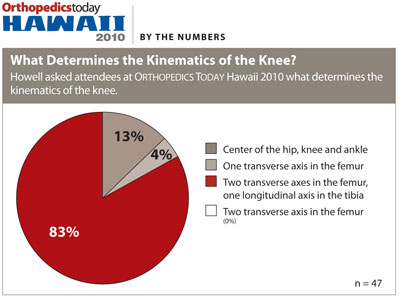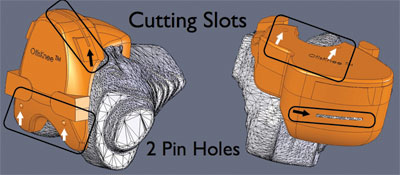Shape-fit cutting guides for total knee replacement lower operating time, raise patient satisfaction
One physician has worked extensively with the guides and thinks they “are here to stay.”
Though they are new and have yet to be fully integrated into common practice, patient-specific cutting guides for knee replacement can present a number of advantages for physicians, according to a professor of mechanical engineering at the University of California, Davis in Sacramento.
The findings were presented by Stephen M. Howell, MD, at Orthopedics Today Hawaii 2010. Howell explained that he started using the guides in 2006. He has since performed nearly 1,000 surgeries using them, and noted that there have been about 23,000 nationwide uses.
“I think patient-specific cutting guides are here to stay,” he said. “How they will eventually fit in I do not know, but there are a lot of economies to the patient, surgeon, OR staff, and implant companies.”
|
|
Defining kinematics
Howell said the patient-specific guides aid in replicating the kinematics of the joint, which he defined as “the relative position of the patella to the femur, to the tibia at any knee position without forces applied to the joint.” These are defined by three axes, all of which are either parallel or perpendicular to each other.
Realignment is accomplished by preserving the ligaments, removing osteophytes (restoring the ligament length) and filling in defects on the femur and tibia.
The key step in restoring kinematics is co-aligning the transverse axis of the femoral component with the transverse axis in the femur about which the tibia flexes and extends (Figure 1). Co-aligning the transverse axis of the femoral component with the femur, equalizing the medial/lateral joint space, and centering the tibia under the femur restores stability, motion and patella tracking.
|
Images: Howell SM |
“That puts the knee back to how it was maybe when the patient was 35 years old, before the arthritis took place,” Howell said.
Reduced operating time
The numerous advantages that Howell outlined with regards to using shape-fit cutting guides included reductions in both operating room (OR) time and turnover time.
“It does tend to shorten the OR time because a lot of the decisions are made beforehand,” he said. “It also shortens the turnover time, because you only need one tray of instruments to do the surgery. You know the size of the implants ahead of time and thus can open them ahead of time, and it shortens the amount of time in the hospital for us.”
|
|
In addition, Howell noted, kinematic alignment has given his patients a more expedient recovery while also increasing their satisfaction with the procedure.
“The take-home message is that our patients have done better,” he added. “There is a lot of room for improvement … we have a lot to learn. I’m the first to acknowledge that. We are not perfect with our total knees,” Howell said. “There are kinematics in the knee that we need to understand, respect, and preserve.”

Work yet to be done
Though work is yet to be done to determine its place and value, Howell noted that he has seen consistent recovery and high patient satisfaction, with length of stay figures that have 92% of patients staying no more than 2 nights in the hospital, and 98% of those patients going straight home afterward. — by Robert Press
References:
- Howell SM, et al. Assessment of the radii of the medial and lateral femoral condyles in varus and valgus knees with osteoarthritis. J Bone Joint Surg (Am). 2010;92(1):98-104.
- Howell SM, et al. Method for quantifying patient expectations and early recovery after total knee arthroplasty. Orthopedics. 2009;32(12):884-890.
- Howell SM et al. Method In vivo adduction and reverse axial rotation (external) of the tibial component can be minimized. Orthopedics. 2009:32(5):319.
- Howell SM, et al. Results of an initial experience with custom-fit positioning total knee arthroplasty in a series of 48 patients. Orthopedics. 2008;31(9):857-863.
- Howell SM. Shape-fit cutting guides for TKR. Presented at Orthopedics Today Hawaii 2010. Jan. 10-13. Hawaii’s Big Island.
- Stephen M. Howell, MD, can be reached at Timberlake Professional Building, 8100 Timberlake Way, Suite F, Sacramento, CA 95823; 916-689-7370; e-mail: sebhowell@mac.com.



